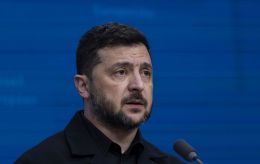Russians expand foothold near Lyman - ISW reveals Russia's plans
 Illustrative photo: Russian army prepares to occupy new settlements in the east (Getty Images)
Illustrative photo: Russian army prepares to occupy new settlements in the east (Getty Images)
The Russian army has a tenfold advantage in manpower near the city of Lyman in the Donetsk region and is preparing for a further large-scale offensive in this area, according to a report from the Institute for the Study of War (ISW).
On March 28 and geolocated on April 1, footage revealed that Russian troops had recently advanced northwest of Novolyubivka (northeast of Lyman) and had likely captured this village. Additionally, Russian forces recently achieved confirmed progress southeast of Novo (west of Novolyubivka).
On March 31, Ukrainian military analyst Kostyantyn Mashovets stated that Russian forces had advanced to the southern outskirts of Katerynivka (northwest of Novolyubivka).
The ISW reminded that, at the beginning of January, the Russian army crossed the Zherebets River to the western (right) bank and, over the last three months, slowly expanded its bridgehead on the right bank.
"Russian forces advanced across the Zherebets River onto the west (right) bank in early January 2025 and have slowly expanded their bridgehead on the right bank over the last three months," noted the Institute for the Study of War.
The report also highlighted that Russian military bloggers and Mashovets consistently attributed the initial movement to the western bank and the subsequent expansion of the bridgehead to elements of the 144th and 3rd Motorized Rifle Divisions (20th Combined Arms Army of the Moscow Military District).
Tenfold advantage
ISW analysts are convinced that Russian forces appear to be utilizing their significant manpower advantage to advance in this area. A spokesman for the Ukrainian brigade operating in the Lyman direction stated on March 31 that since January 2025, the Russians have been conducting almost exclusively infantry attacks in this area and rarely using armored vehicles.
The Institute for the Study of War also stated that they had not observed any video footage of notable Russian mechanized attacks in this area in 2025.
The Ukrainian grouping Khortytsia reported on March 31 that Russian forces had intensified infantry attacks in the Lyman direction and had significantly more troops in the area, mostly well-trained contract soldiers. Another Ukrainian brigade operating in the Lyman direction reported on March 24 that on some sections of these areas, Russian forces have a tenfold advantage in manpower over the Defense Forces.
"The Russian military command appears to be reinforcing and replacing manpower losses among frontline units of the 3rd and 144th motorized rifle divisions, as these formations have been in the area since at least 2023 and do not appear to have withdrawn for rest and reconstitution at any point," the ISW noted.
Two bridgeheads into one
The report also suggested that Russian forces might use their expanded bridgehead northeast of Lyman to support the capture of Borova or Lyman in the coming months.
The ISW noted that Russian forces initially focused on advancing from Ivanivka towards Kolodiaziv (southwest of Ivanivka) in the general direction of Lyman, but recently appear to have reoriented their efforts to advance northwest of Ivanivka towards Novo and Katerynivka in the general direction of Borova.
One of the Russian military bloggers noted on April 1 that Russian forces are trying to link their bridgehead near Novolyubivka with a smaller bridgehead on the western bank near Makiyivka (about eight kilometers away). The Russians are likely trying to connect these bridgeheads to create a sustainable protrusion to support attacks southeast of Borova.
Thus, the Russians may be creating a bridgehead northeast of Lyman to support future offensive operations against the southern edge of the line from Novosergiyivka - Druzhlyubivka - Novyi Myr (east and southeast of Borova).
"The Russian military command may attempt to outflank Ukrainian defenses in these settlements in order to force Ukrainian troops to withdraw and enable Russian advances east of and into Borova in the coming months," the ISW stated.
The Institute added that the Russians might also try to use the expansion of the bridgehead on the western bank of the Zherebets River near Ivanivka to support future Russian operations to capture Lyman.
"Further Russian advances towards Borova and Lyman are part of an enduring Russian effort to push Ukrainian forces from positions on the east bank of the Oskil River and attack further into western Kharkiv Oblast and set conditions to attack the Ukrainian fortress belt in Donetsk Oblast from the north," the Institute for the Study of War is convinced.
Luhansk region capture and negotiations
Additionally, the ISW believes that Russian forces may also use their bridgehead northeast of Lyman to capture the remaining one percent of the Luhansk region under Ukrainian control.
The Institute for the Study of War does not rule out that the Kremlin will likely use the second capture and retention of the Luhansk region to gain leverage during ongoing ceasefire negotiations and future peace talks.
"ISW continues to assess that Russian officials are intentionally stalling the ceasefire and peace negotiations in hopes of gaining more territory to leverage during future peace negotiations," the report concludes.
Frontline update
The situation on the frontlines of the Russia- Ukraine war remains complicated. As of the evening of April 1, there had been 141 combat engagements, with the Russians attacking Ukrainian positions in the Lyman direction 13 times.
Since the beginning of the full-scale war, the Russian army has lost over 916,000 military personnel.
Recently, Ukrainian paratroopers dramatically blew up trenches with Russians.

